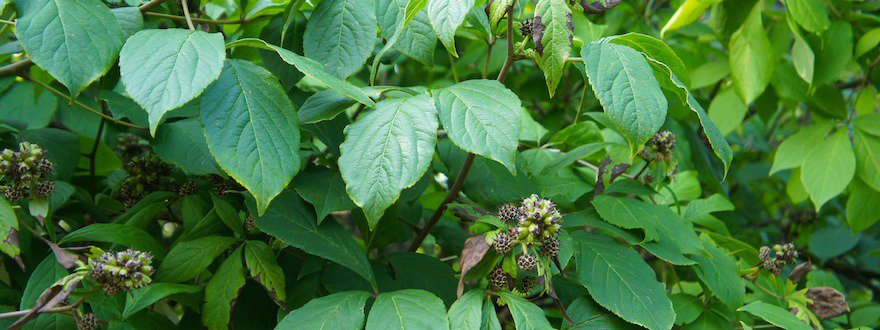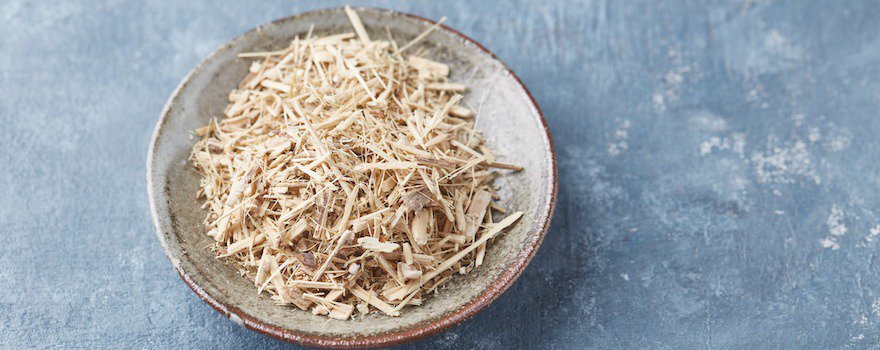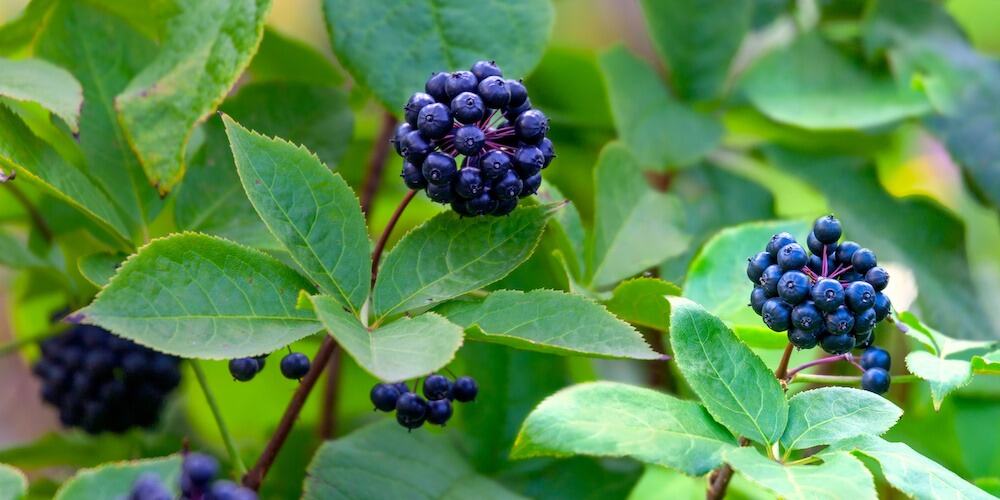BENEFITS OF ELEUTHEROCOCCUS
✓ Improves resistance to stress
✓ Stimulates and regulates the immune system
✓ Tones the body and reduces fatigue
✓ Enhances cognitive functions
✓ Regulates blood sugar
What is Eleutherococcus?
Eleutherococcus is a shrub belonging to the Araliaceae family. It includes the famous ginseng (Panax ginseng) and ivy, common in our regions. The Eleutherococcus genus comprises about thirty species, including Eleutherococcus senticosus and Eleutherococcus sieboldianus. While the latter is also part of the traditional Chinese pharmacopeia, it is Eleutherococcus senticosus that is used worldwide today for its medicinal properties. Thus, when referring to Eleutherococcus, we commonly mean this species.
Eleutherococcus originates from Eastern Siberia, the Asian part of Russia. Hardy and capable of withstanding very low temperatures, it also grows in the cold regions of China, Japan, and South Korea.
Due to its geographic origin and its belonging to the same family as ginseng, Eleutherococcus is nicknamed the “Siberian ginseng.” However, while they share some properties, these two plants should not be confused.
Reaching up to 3 m in height, Eleutherococcus is a very thorny shrub, earning it the nickname “devil’s bush.” It has palmate green leaves and uniquely features flowers of different colors: purple for male flowers and yellow-green for female flowers. After flowering, the shrub produces numerous black berries in clusters. However, the medicinal interest of Eleutherococcus lies in its root…

Also called “taiga root”, Eleutherococcus has been used for medicinal purposes since Antiquity. In Northeast Asia, it is consumed as an infusion or decoction for its tonic and anti-fatigue action. It is particularly known for increasing longevity and strengthening the immune system. In traditional Chinese medicine, it is also among the tonifying plants of the spleen like astragalus (Astragalus membranaceus) and ginseng.
It was from the 1950s, thanks to scientific research, that Eleutherococcus became known beyond Russian and Chinese borders. Today, it is a well-regarded plant worldwide, consumed as a dietary supplement.
Nutritional Composition
- Amino acids
- Vitamins: pro-vitamin A (beta-carotene), C, E
- Minerals and trace elements: calcium, phosphorus, potassium, magnesium, sodium, aluminum, iron, bromine, copper, zinc, chromium, germanium
- Saponins: eleutherosides B (syringin), E, and A
- Polysaccharides: eleutherans A and G
- Phenolic compounds: coniferin
- Phenolic acids: chlorogenic acid, caffeic acid
- Heterosides
- Lignans
- Coumarins: isofraxidin
- Sterols: daucosterol, sistosterol
- Resins

The benefits of Eleutherococcus
🙏🏻 Improves resistance to stress
Like ginseng, maca (Lepidium meyenii) or rhodiola (Rhodiola rosea), Eleutherococcus is an adaptogenic plant. It thus increases the body’s resistance to various stress situations (physical or psychological) and helps it to better defend itself.
The adaptogenic properties of Eleutherococcus are due to the eleutherosides contained in its root, particularly eleutherosides E. On one hand, eleutheroside E acts on corticosterone, a hormone released by the adrenal glands in response to stress. By reducing the production of corticosterone, eleutheroside E thus has a calming and anti-stress effect.
On the other hand, eleuthero contributes to the maintenance of homeostasis, meaning the balance of the organism. Thus, it acts as a stabilizer to facilitate a return to equilibrium in stressful situations.
Finally, eleuthero contains vitamins, minerals, and trace elements that help reduce stress and anxiety. This includes vitamin C (or ascorbic acid), zinc, magnesium, and calcium.
This study from Ehime University (Japan) shows how eleutheroside E reduced corticosterone levels in stressed mice.
🛡 Stimulates or regulates the immune system
Numerous studies have demonstrated that eleuthero has a beneficial effect on immunity. It acts on both natural defenses and the immune system response.
Eleuthero increases the quantity of lymphocytes (white blood cells) that help the body fight diseases and infections. It also promotes the production of interleukin-1 and interleukin-6, involved in immunity. Finally, eleuthero improves humoral response, meaning the production of antibodies in case of aggression. In this sense, it has immunostimulating properties.
But eleuthero can both stimulate and inhibit reactions of the immune system when they are overly active and excessive. This is the case during allergies or some autoimmune diseases. Thus, eleuthero regulates and exerts an immunomodulatory effect.
Like cordyceps (Ophiocordyceps sinensis) and reishi (Ganoderma lucidum), it also contains germanium, a trace element that helps maintain the immune system in balance.
This study from the National Institute of Tuberculosis and Lung Diseases (Poland), conducted on mice, demonstrates that eleuthero has immunomodulatory properties and improves cellular and humoral response.
This other study from the pharmaceutical company Boehringer Ingelheim (Germany), conducted on rats, also shows the beneficial effects of eleuthero on immunity.
⚡️ Tones the body and reduces fatigue
In traditional Chinese medicine, eleuthero is considered a general tonic and is indicated for fighting against physical or mental fatigue. Today, this action is recognized by the EMA (European Medicines Agency), the WHO (World Health Organization), and Commission E.
Again, it is the eleutherosides, particularly eleutheroside E, that are responsible for the anti-fatigue action of eleuthero. But it also contains other tonifying nutrients like vitamin C, calcium, magnesium, and zinc.
Thus, eleuthero is particularly beneficial for the elderly, during intense physical efforts, mental overexertion, transient or chronic fatigue, in cases of viral diseases, or during a convalescent period.
This study from the Second Military Medical University in Shanghai (China), conducted on mice, shows the effectiveness of eleutherosides in alleviating physical and mental fatigue.
This other study from the University of Iowa (United States), conducted on patients suffering from chronic fatigue, shows the potential of eleuthero to reduce the severity and duration of fatigue.
👩🏻🏫 Improves cognitive functions
Eleuthero has a beneficial effect on cognitive functions, particularly on concentration and short-term memory. Like ginkgo biloba, it is an intellectual stimulant that enhances brain functions.
This action is due to the presence of pro-vitamin A (or beta-carotene) which protects brain cells, limits cognitive decline, and improves memory. Its effect is amplified when combined with vitamin C.
Finally, Eleutherococcus contains iron, an oligoelement essential for neurons as it promotes their oxygenation. Thus, Siberian ginseng makes the brain more efficient and helps improve memory.
Because it is also adaptogenic and improves stress management, Eleutherococcus is the ideal ally for students during exams.
This study from the Stavropol Medical Academy (Russia), conducted on humans, shows the beneficial effects of Eleutherococcus on short-term memory.
🍭 Regulates blood sugar
Eleutherococcus seems promising for regulating blood sugar in people with diabetes. Indeed, it contains syringin, an active principle also present in certain plants like lilac, forsythia, or privet.
Syringin exerts a hypoglycemic effect (lowers blood sugar levels) and improves glycogen synthesis in cells. Furthermore, eleutheroside E improves insulin resistance while reducing blood sugar and promoting glucose absorption.
This study from Taipei Medical University (Taiwan), conducted on diabetic rats, confirms the hypoglycemic effect of syringin from Eleutherococcus.
This other study from the Korea Food Research Institute (South Korea), conducted on mice, shows the usefulness of eleutheroside E in cases of type II diabetes mellitus.

How to consume Eleutherococcus?
Eleutherococcus in tablets
Eleutherococcus tablets or capsules are easy to find in organic and specialized stores or online. They contain powdered dried root.
To fully benefit from the effects of Eleutherococcus, the tablets must be sufficiently titrated in eleutherosides (at least 0.8%, or 3.8 mg of eleutherosides for 480 mg of powder).
Eleutherococcus in powder
Eleutherococcus is also offered in powder form. After harvesting, the root is dried and then ground into powder for sale. It generally contains between 0.6 and 0.9% eleutherosides.
Eleutherococcus powder easily mixes with water, fruit juice, or plant-based milk. It can also be used to prepare an infusion. To do this, pour 2 to 4 g of Eleutherococcus powder into 150 ml of boiling water. Let steep for 10 minutes and sweeten by adding a spoonful of honey.

Eleutherococcus in mother tincture
The mother tincture of Eleutherococcus is obtained by hydroalcoholic maceration of the root. This form of dietary supplement is generally concentrated in eleutherosides. It easily dilutes in a little water or fruit juice.
However, the mother tincture has the drawback of containing a lot of alcohol. It is thus not recommended for pregnant women, children, or people with certain medical conditions.
Eleutherococcus and medicinal plants
Eleutherococcus is associated with many medicinal plants and superfoods. Against physical fatigue, you can complement your Eleutherococcus intake with spirulina (Arthrospira platensis) or acerola (Malpighia emarginata).
In case of overwork or to improve your intellectual performance, combine eleuthero with bacopa (Bacopa monnieri), ginkgo biloba or even maca (Lepidium Meyenii) which boost concentration and memory.
Consume sustainably: choose organic and fair-trade eleuthero
✓ We advise you to choose eleuthero certified organic, cultivated according to organic farming principles and thus without chemicals. In addition to protecting the environment, you will avoid pesticide residues in the finished product. Also opt for capsules without GMOs, excipients, preservatives, and that are non-ionized.
✓ Today, eleuthero mainly comes from China, South Korea, and Japan. In China, the climate and soils of Shanxi province, in the northeast, and Hebei, in the east, are particularly conducive to its cultivation.
✓ Unfortunately, the growing global demand leads to intensive harvesting. In Korea, for example, eleuthero is a protected plant because it is endangered. When choosing your dietary supplement, ensure you check the origin and favor fair-trade sources.
Dosage
⚖️ The recommended dosage ranges from 0.5 to 4 g of eleuthero per day.
⏳ To achieve results, doses must be regular and continue for at least 6 weeks. However, it is not recommended to take eleuthero for more than 3 consecutive months.
⏳ It is advised not to consume eleuthero late in the day to avoid insomnia. Prefer taking it in the morning or at noon. Also, avoid consuming other stimulants like coffee to not disturb sleep.
⏳ It is possible to consume eleuthero in the form of 6-week courses, 3 to 4 times a year, taking breaks between each. These courses are interesting in cases of intense fatigue, convalescence, or as a preventive measure before seasonal changes to strengthen the body.
💊 In tablets: 0.5 to 4 g per day, in 1 to 3 doses.
🥄 In powder: 1 g, 2 to 3 times per day.
🍵 As an infusion: 2 cups per day.
🧪 As a mother tincture: 3 x 20 to 40 drops per day.
Contraindications and side effects
The consumption of eleuthero presents certain contraindications:
- As a precaution, young children, pregnant or breastfeeding women should avoid taking eleuthero.
- People suffering from hypertension, heart problems (rheumatic carditis, atherosclerosis) or nervous disorders should avoid consuming it;
- Diabetic individuals, those with obesity or hormone-dependent cancer should consult their doctor before taking it;
- Eleuthero can interact with medications such as hypoglycemic agents, anticoagulants, hypotensive or hypertensive drugs.
Excessive consumption of eleuthero can lead to the following side effects:
- Increased blood pressure.
- Headaches.
- Palpitations and tachycardia.
- Insomnia.
- Diarrhea.
- Irritability, overexcitement, and restlessness.
If you experience side effects, stop your consumption and consult a doctor.
History, culture, and market of eleuthero
In China, eleuthero has been used for over 4000 years due to its medicinal properties. At a time when Korean ginseng was particularly expensive and subject to excessive harvesting, eleuthero was a local, abundant, and much more affordable plant, hence its nickname “poor man’s ginseng.”
But it was not until the 20th century that the plant gained significant popularity. In the 1950s, doctors Brekhman and Lazarev, who had already conducted extensive research on adaptogenic plants, highlighted the benefits of eleuthero in stress management.
Later, in the 1970s, eleuthero became very popular in Russia. It is said that Russian athletes consumed it to improve their sports performance. Finally, although unverified, it is rumored that astronauts on the Mir space station also consumed eleuthero to increase their strength, endurance, and minimize the effects of weightlessness.

Report prepared by Julia Perez and Charlotte Jean
Sources and scientific studies
Shu Zhu, Yanjing Bai, Mayuko Oya, KenTanaka, KatsukoKomatsu, Takuro Maruyama, Yukihiro Goda, Takeshi Kawasaki, Masao Fujita, Toshiro Shibata, 2011. Genetic and chemical diversity of Eleutherococcus senticosus and molecular identification of Siberian ginseng by PCR-RFLP analysis based on chloroplast trnK intron sequence.
Kimura Y, Sumiyoshi M, 2004. Effects of various Eleutherococcus senticosus cortex on swimming time, natural killer activity and corticosterone level in forced swimming stressed mice.
Rogala E, Skopińska-Rózewska E, Sawicka T, Sommer E, Prosińska J, Drozd J, 2003. The influence of Eleuterococcus senticosus on cellular and humoral immunological response of mice.
Steinmann GG, Esperester A, Joller P, 2001. Immunopharmacological in vitro effects of Eleutherococcus senticosus extracts.
Huang LZ, Huang BK, Ye Q, Qin LP, 2011. Bioactivity-guided fractionation for anti-fatigue property of Acanthopanax senticosus.
Hartz AJ, Bentler S, Noyes R, Hoehns J, Logemann C, Sinift S, Butani Y, Wang W, Brake K, Ernst M, Kautzman H, 2004. Randomized controlled trial of Siberian ginseng for chronic fatigue.
Arushanian EB, Baĭda OA, Mastiagin SS, Popova AP, Shikina IB, 2003. [Effect of eleutherococcus on short-term memory and visual perception in healthy humans].
Niu HS, Liu IM, Cheng JT, Lin CL, Hsu FL, 2008. Hypoglycemic effect of syringin from Eleutherococcus senticosus in streptozotocin-induced diabetic rats.
Jiyun Ahn, Min Young Um, Hyunjung Lee, Chang Hwa Jung, Seok Hyun Heo, et Tae Youl Ha, 2013. Eleutheroside E, An Active Component of Eleutherococcus senticosus, Ameliorates Insulin Resistance in Type 2 Diabetic db/db Mice.



